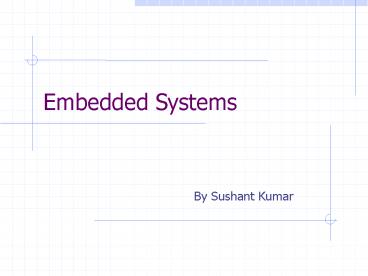Embedded Systems PowerPoint PPT Presentation
Title: Embedded Systems
1
Embedded Systems
- By Sushant Kumar
2
Structure of the seminar
- Introduction
- History of embedded systems
- Characteristics
- Embedded systems for meters
3
Introduction
- Part 1
4
What is an Embedded System ?
An embedded system is a special-purpose computer
system designed to perform a dedicated function
5
An Embedded system
A generic embedded system
6
Why Embedded system ?
- Performance
- Technology Advances
- CMOS VLSI dominates older technologies (TTL, ECL)
- Computer architecture improvements
- RISC, superscalar, RAID,
- Price
- Simpler development
- CMOS VLSI smaller systems, fewer components
- Higher volumes
- CMOS VLSI same device cost 10,000 vs.
10,000,000 units
7
Embedded system vs General Computer
- Performs one or a few pre-defined tasks
- Very specific requirements
- Task-specific hardware and mechanical parts
- Often mass-produced
- Design engineers can optimize it
8
Embedded System
Microprocessor
Micro controller
Micro controllers have built in peripherals and
memory which reduces the size of the system
9
Application Areas
- Signal processing systems
- Real-time video, DVD players, Medical equipment.
- Distributed control
- Network routers, switches, firewalls,
- Small systems
- Mobile phones, home appliances, toys, smartcards,
MP3 players, PDAs, digital cameras, sensors, pc
keyboard mouse - Modern cars Up to 100 or more processors
- Engine control unit
- ABS systems (Anti Lock Brake systems)
- Emissions control
- Diagnostics and Security systems
- Accessories (doors, windows etc)
10
History of Embedded Systems
- Part 2
11
Apollo Guidance computer
The Apollo Guidance Computer, the first
recognizable modern embedded system developed by
Charles Stark Draper at the MIT Instrumentation
Laboratory
12
Minuteman Missile 1966
- First mass-produced embedded system
- Autonetics D-17 guidance computer
- Built from transistor logic
- Reduced prices on nand gate ICs from 1000/each
to 3/each - Medicinal appliances
- Avionics, such as inertial guidance systems,
flight control systems - Cellular telephones and telephone switches
- Home automation products
13
Other developments
First Microprocessor Intel 4004 Required external memory and support chips By mid 1980s micro controllers came into existence
cost of a microcontroller fell below 1 By the end of the 80s, embedded systems were the norm rather than the exception
14
Moores law
15
Characteristics of Embedded Systems
- Part 2
16
Characteristics of Embedded Systems
- Interface
- Complexity
- Platform
- Peripherals
- Tools
- Reliability
- Volume
17
1. Interface
Interface
No User Interface
Full User Interface
Performing user- defined PDAs
Dedicated to one Task Missile guidance system
18
2. Complexity
Complexity
Simple systems
Complex systems
- Connected to a network
- Touch screen
- Real time constraints
- Part of a critical operation
- Use buttons,small character/ digit-only displays
- simple menu system
19
3. CPU Platform
- Many different CPU architectures used in embedded
designs such as ARM, MIPS, x86, PIC, 8051 etc - Desktop computer market is limited to just a few
architectures
20
CPU Platform
- PC/104 is a typical base for small, low-volume
embedded system design. - Uses an embedded real-time operating system such
as MicroC/OS-II, QNX or VxWorks
21
CPU Platform
- Very-high-volume embedded systems use the system
on a chip (SoC), an application-specific
integrated circuit (ASIC) - CPU core was purchased and added as part of the
chip design.
22
4. Peripherals
- Serial Communication Interfaces
- Universal Serial Bus (USB)
- Networks Ethernet, Controller Area Network
- Timers PLL(s), Capture/Compare and Time
Processing Units - General Purpose Input/Output (GPIO)
- Analog to Digital/Digital to Analog (ADC/DAC)
23
5. Tools
- Embedded system designers use compilers,
assemblers, and debuggers - Utilities to add a checksum or CRC to a program
- Emulator replaces the microprocessor with a
simulated equivalent
24
6. Reliability issues
- System cannot be shut down for repair
- Solutions involve subsystems with spares
- system must be kept running for safety and
monetary reasons
25
7. Volume
Volume
High Volume
Low Volume
Minimizing cost is usually the primary design
consideration
Used when cost is not a major factor Performance
and reliability constraints
26
Embedded systems for Meters
- Part 4
27
Electric power consumption
- Electric power consumption is not constant whole
day - Peak period is between 1 pm and 4 pm
- System must be engineered to meet peak power
28
Limitations of the meter
- Mechanical device
- Prone to wear,shock
- Maintains no record of time
- Only Counts the number of rotations of the wheel
29
Demand Curve
30
Real power limitation
- Ideally current and voltage are in phase
- Every volt-ampere delivered becomes a watt of
power used - Induction motors and lamp ballasts cause current
to flow out of phase - Fewer actual watts are used than delivered
31
Ideal power curve
32
When current and voltage are not in-phase
33
Power factor penalty
- Industrial customers must by contract maintain
power factor - Power factorRatio of real power used to volt
amperes delivered - Pay penalty if above some agreed upon values
34
Multi function meter
- Extend for smaller commercial customer
- Even for residences
- Contract can be varied
35
Billing
- Networked system can facilitate automation
- No need to send personnel
- Better accuracy and lesser burden
36
Design Fundamentals
- Means of taking samples
- Display
- Communication subsystem
- Non-volatile memory
- Power supply
- Stored program micro-controller
37
Hardware design
38
Choosing a micro-controller
- Feature set
- Code space
- Data Space
- Data converter
- Real-time clock
39
Conclusion
- A quiet revolution is in progress in the utility
industry. - Static metering devices, have been in use for the
better part of a century - Gradually being replaced with multi-rate,
multifunction meters - Capable of more accurately accounting for utility
usage.
40
References
- www.maxim-ic.com
- www.electronicsforu.com
- www.refdesign.techonline.com
- www.wikipedia.org
- www.powerelectronics.com
- www.ucpros.com
- www.pdfserv.maxim-ic.com
41
For detailed report
- www.sushantkumar.wordpress.com/tech
42
Thank You ?

